Hyundai Tucson
The Hyundai Tucson (Korean: 현대 투싼) (pronounced Tu-són) is a compact crossover SUV produced by the South Korean manufacturer Hyundai since 2004. In the brand's lineup, the Tucson fits below the Santa Fe and Veracruz. It is named after the city of Tucson, Arizona.
| Hyundai Tucson | |
|---|---|
 | |
| Overview | |
| Manufacturer | Hyundai |
| Production | 2004–present |
| Model years | 2005–present |
| Body and chassis | |
| Class | Compact crossover SUV |
| Body style | 5-door SUV |
| Layout | front engine, front wheel drive front engine, four wheel drive[1][2][3] |
First generation (JM; 2004)
| First generation (JM) | |
|---|---|
 | |
| Overview | |
| Also called | Hyundai JM |
| Production |
|
| Assembly |
|
| Body and chassis | |
| Related | |
| Powertrain | |
| Engine |
|
| Transmission | |
| Dimensions | |
| Wheelbase | 2,630 mm (103.5 in) |
| Length | 4,325 mm (170.3 in) |
| Width | 1,795 mm (70.7 in) |
| Height | 1,730 mm (68.1 in) |
| Curb weight | 1,470–1,529 kg (3,241–3,371 lb)[4][5][6][7] |
.jpg)
The first-generation Tucson was launched in 2004.[8] It shared its Hyundai Elantra-based platform with the second-generation Kia Sportage.
Powertrain
| Model | Years | Transmission | Power@rpm | Torque@rpm | 0–100 km/h (0–62 mph) (Official) | Top speed |
|---|---|---|---|---|---|---|
| Petrol | ||||||
| Beta II 2.0 | 2004–2009 | 5-speed manual 4-speed automatic | 142 PS (104 kW; 140 hp) @ 6000 rpm | 18.8 kg⋅m (184 N⋅m; 136 lbf⋅ft) @ 4500 rpm | 10.4s (FWD manual) 11.3s (AWD manual) | 180 km/h (112 mph) (FWD manual) 174 km/h (108 mph) (FWD automatic) 174 km/h (108 mph) (AWD manual) |
| Delta 2.7 | 4-speed automatic | 175 PS (129 kW; 173 hp) @ 6000 rpm | 24.6 kg⋅m (241 N⋅m; 178 lbf⋅ft) @ 4000 rpm | 10.5s | 180 km/h (112 mph) | |
| Diesel | ||||||
| RA 420 2.0 CRDi | 2004–2009 | 5-speed manual 4-speed automatic | 113 PS (83 kW; 111 hp) @ 4000 rpm | 25 kg⋅m (245 N⋅m; 181 lbf⋅ft) @ 1800-2500 rpm | 13.1s (FWD manual) 13.8s (AWD manual) 15.1s (FWD automatic) 16.1s (AWD automatic) | 168 km/h (104 mph) (manual) 162 km/h (101 mph) (automatic) |
| 2006–2009 | 6-speed manual 4-speed automatic | 140 PS (103 kW; 138 hp) @ 4000 rpm 150 PS (110 kW; 148 hp) @ 4000 rpm | 31.1 kg⋅m (305 N⋅m; 225 lbf⋅ft) @ 1800-2500 rpm | 11.1s (FWD manual) 12.0s (AWD manual) 12.8s (FWD automatic) | 178 km/h (111 mph) (FWD manual) 177 km/h (110 mph) (AWD manual) 175 km/h (109 mph) (FWD automatic) | |
Equipment
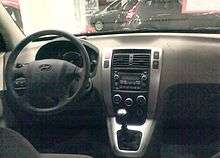
In the U.S., the Tucson was offered in base GLS, mid-line SE, and top-tier Limited (formerly LX) trim levels for 2007 models. Earlier 2005 and 2006 models were offered as GL/GLS/Limited. Standard equipment included air conditioning, six airbags, electronic stability control, a CD player, alloy wheels, remote keyless entry, and premium cloth seats. The SE added to the roster with contrasting gray body cladding, a different alloy design, an AM/FM/Cassette/CD as well as fog lights and a front windshield wiper de-icing grid. The Limited added leather seating surfaces, a 6-disc in dash CD changer, body-colored cladding, automatic climate control, and heated seats. The SE and Limited were only available with the 2.7 L V6. The GLS came only with the 2.0-liter four-cylinder.
The Tucson offers modest cargo space but its easy-to-fold seats can expand this volume so they lie flat. Even the front passenger seat folds flat for extra-long cargo.
Safety
There are dual-stage frontal impact airbags, torso side-impact airbags built into the front seats, and curtain airbags for side-impact protection for front and rear passengers.
2009 Hyundai Tucson by the U.S. National Highway Traffic Safety Administration (NHTSA)[9]
- Frontal Rating (Driver):





- Frontal Rating (Passenger):





- Side Rating (Driver):





- Side Rating (Passenger):





Model year changes
Changes for 2006 were minimal. The LX became the Limited and got color-coded cladding, automatic climate control, and a high-performance sound system. The GLS retained the gray cladding but 'HYUNDAI' is no longer branded into the cladding on the front doors. The GLS also got improved cloth seats with the option of a heating element. Both GLS and Limited got redesigned alloy wheels. The base GL remained unchanged.
Changes for 2007 were also minimal. The GL and GLS trims were renamed to GLS and SE, respectively, to match the standard for all new Hyundai vehicles. The SE comes with a sport utility rack, has 4 wheel drive, and is a 6 cylinder engine.
2009 Tucsons saw minor restyling and trim changes.
Tucson FCEV (2005)
The Tucson Fuel Cell Electric Vehicle (FCEV) is a test fuel cell vehicle for Hyundai's 2nd generation hydrogen fuel cell. The vehicle includes an 80 kW electric motor by Enova Systems of Torrance, California, UTC Fuel Cells by South Windsor, Connecticut, 152V battery co-developed by Hyundai Motor Co. and LG Chem in Seoul, Korea, 152 litres (33 imp gal; 40 US gal) hydrogen storage tanks developed by Dynetek Industries of Calgary, Alberta, Canada. The vehicle has range of 300 kilometres (186.4 mi) and top speed of 150 km/h (93 mph).[10]
The vehicle was unveiled in 2005 at the Los Angeles Auto Show[11] and completed a 4,300-mile (6,900 km) journey as part of the Hydrogen Road Tour in 2008.[12]
CRTD Xenith (2007–2009)
It is a version of the 2.0 CRDi 6-speed manual 4WD for UK market. It included following:
- Color-coded side mouldings and bumpers
- Rear privacy glass
- Two tone leather and Alcantara upholstery
- Alcantara covered instrument cluster surround, gear gaiter, steering wheel, handbrake, armrest, door pull linings and door inserts
- Birds eye black maple wood effect trim on dashboard, console and door pulls
- Leather and alloy sports gear knob
- Luxury stainless steel embossed door entry guards
- Aluminum sports pedal trims
- 19" multi spoke alloy wheels with polished rims
The vehicle has MSRP of £20,670.[13]
25th Anniversary Edition (2009)
It is a version of the 2009 Tucson 2.0 GLS FWD model with premium Kenwood stereo system, a Garmin in-dash GPS system, a 2-way power sunroof, body color door handles and mirrors.[14] The options cost $1,000.[15]
International markets
In Japan, the Hyundai Tucson was sold as the Hyundai JM until November 2009. The Tucson was also sold in Europe, but not EuroNCAP tested.
A facelifted version of the first generation exclusive to China was produced by Beijing Hyundai. The second generation Tucson was renamed to ix35 in China and Brazil, and later became an independent model while the Tucson name returned with the introduction of the third generation.
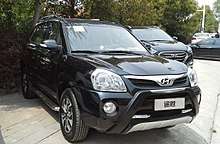
Reception
The Hyundai Tucson received accolades from Canadian Car of the Year Best New Crossover award for 2005. It was named as one of the most reliable vehicles from the 2009 Consumer Reports reliability survey.[16]
Second generation (LM; 2009)
| Second generation (LM) | |
|---|---|
 | |
| Overview | |
| Also called |
|
| Production | 2009–2015 |
| Model years | 2010–2015 |
| Assembly |
|
| Designer | |
| Body and chassis | |
| Related | |
| Powertrain | |
| Engine |
|
| Transmission | |
| Dimensions | |
| Wheelbase | 2,640 mm (103.9 in) |
| Length | 4,475 mm (176.2 in) |
| Width | 1,850 mm (72.8 in) |
| Height | 1,645–1,685 mm (64.8–66.3 in) |
| Curb weight | 1,425–1,580 kg (3,142–3,483 lb) |
In most markets outside South Korea and North America, the Hyundai Tucson name (also known as the "Hyundai Tucson ix" in Korea) was retired in favor of Hyundai ix35. Vehicles sold in the U.S. continued to be called Tucson.[19] The ix35 was unveiled at the 2009 Frankfurt Motor Show.[20] The power output, fuel-efficiency, comfort and safety features have been all upgraded. Known by the project name LM, it took 36 months and 280 billion won (approx. US$225 million) to develop.
Chinese market
In China, the first generation Tucson was sold alongside the ix35, and was replaced by the third generation Tucson directly while the ix35 spawned its own successor, the ix35 II. The Hyundai ix35 II was revealed on the 2017 Shanghai Auto Show in China; it was available to the Chinese car market in Q3 2017.[21]
Design
The ix35's styling was reported to be based on Hyundai ix-onic concept.[22] The ix35 was penned by Hyundai designer Cha Il-Hoei in 2007, under the guidance of former BMW designer Thomas Buerkle at Hyundai's Russelsheim design studio in Germany and continues the company's styling language, marketed as "fluidic sculpture".[23][24] The compact crossover vehicle has sweeping coupe-like lines, a premium vehicle feel and comes with features unavailable on its predecessor.
Pre-facelift styling
_Elite_wagon_02.jpg) Front (ix35 Elite; Australia)
Front (ix35 Elite; Australia)_Active_wagon_02.jpg) Rear (ix35 Active; Australia)
Rear (ix35 Active; Australia)
Post-facelift styling
_Highlander_AWD_wagon_(2015-06-18)_01.jpg) Front (ix35 Highlander; Australia)
Front (ix35 Highlander; Australia)_SE_wagon_(2018-08-06)_02.jpg) Rear (ix35 SE; Australia)
Rear (ix35 SE; Australia)
Powertrain
The Tucson/ix35 is available with several engines: an all-new 2.0-litre diesel R engine, one of two Theta-II petrol engine variants (2.0-litre or 2.4-litre), 1.7-litre UII diesel and 1.6-litre Gamma GDI petrol. The later two only in Europe. The automatic transmission is Hyundai’s all-new six-speed design. The manual transmissions available in Europe is a 6-speed for 1.7-litre and 2.0-litre diesels and 1.6 Gamma and a 5-speed for 2.0 Theta. The 2.0-liter diesel engine, available outside of North America, meets the Euro-5 emissions standards and achieves 6.5 l/100 km (15.4 km/l; 36.2 mpg‑US) fuel economy with maximum power output of 184 hp (187 PS; 137 kW). The 2.0-litre petrol engine has a fuel economy of 8.5 l/100 km (11.8 km/l; 27.7 mpg‑US) with 166 hp (168 PS; 124 kW). In South Korea, the diesel engine is offered in both front-wheel-drive and all-wheel drive configurations, while the 2.0-litre petrol engine is available only in front-wheel-drive. The North American versions are powered by either the 2.0-litre producing 165 hp (167 PS; 123 kW) or a 2.4-liter four-cylinder petrol engine producing 176 hp (178 PS; 131 kW) mated to the six-speed automatic transmission. The 2.4-litre engine makes almost the same power as the previous generation V6 engine while managing 20% better fuel economy than the previous generation four-cylinder.[25]
The Tucson sold in the United States came in three trims: GL, GLS and Limited, with All-Wheel Drive available for GLS and Limited trims. The GL comes with a standard manual transmission, but a 6-speed automatic transmission is available and is standard on GLS and Limited. Features include available steering wheel-mounted audio controls, hands-free Bluetooth phone connectivity, navigation system, and a standard iPod interface system including iPod cable. An array of advanced safety equipment is standard, including Hillstart Assist Control and Downhill Brake Control. A Proximity Key and Push Button Start system is available in the Korean market but not the North American. The North American version uses a different gauge cluster design than the Korean version.
2014 model Tucson for North America have been upgraded with GDI direct injected Theta II engines that obtain more power and better emissions, LED tail/head lights, more stylish alloy rim designs, and a few minor improvements to the interior/audio system.
| Model | Years | Transmission | Power@rpm | Torque@rpm | 0–100 km/h (0–62 mph) (Official) | Top Speed |
|---|---|---|---|---|---|---|
| Petrol | ||||||
| Gamma II 1.6 GDi | 2009–2015 | 6-speed manual | 135 PS (99 kW; 133 hp) @ 6300 rpm | 16.7 kg⋅m (164 N⋅m; 121 lbf⋅ft) @ 4850 rpm | 11.1s | 178 km/h (111 mph) |
| Theta II 2.0 MPi | 5-speed manual 6-speed automatic | 166 PS (122 kW; 164 hp) @ 6200 rpm | 20.1 kg⋅m (197 N⋅m; 145 lbf⋅ft) @ 4600 rpm | 10.4s (FWD Manual) 10.7s (AWD Manual) 10.6s (FWD Automatic) 11.2s (AWD Automatic) | 184 km/h (114 mph) (FWD Manual) 182 km/h (113 mph) (AWD Manual) 182 km/h (113 mph) (FWD Automatic) 180 km/h (112 mph) (AWD Automatic) | |
| Nu 2.0 GDi | 2013–2015 | 6-speed manual 6-speed automatic | 166 PS (122 kW; 164 hp) @ 6200 rpm | 20.9 kg⋅m (205 N⋅m; 151 lbf⋅ft) @ 4000 rpm | 10.4s (FWD Manual) 10.7s (AWD Manual) 10.4s (FWD Automatic) 11.0s (AWD Automatic) | 196 km/h (122 mph) (FWD Manual) 195 km/h (121 mph) (AWD Manual) 183 km/h (114 mph) (FWD Automatic) 181 km/h (112 mph) (AWD Automatic) |
| Theta II 2.4 MPi | 2009–2015 | 6-speed automatic | 177 PS (130 kW; 175 hp) @ 6000 rpm | 23.1 kg⋅m (227 N⋅m; 167 lbf⋅ft) @ 4000 rpm | 10.0s | 185 km/h (115 mph) |
| Diesel | ||||||
| U II 1.7 CRDi | 2009–2015 | 6-speed manual | 116 PS (85 kW; 114 hp) @ 4000 rpm | 26.5 kg⋅m (260 N⋅m; 192 lbf⋅ft) @ 1250–2750 rpm | 12.4s | 173 km/h (107 mph) |
| R II 2.0 CRDi | 6-speed manual 6-speed automatic | 136 PS (100 kW; 134 hp) @ 4000 rpm | 32 kg⋅m (314 N⋅m; 231 lbf⋅ft) @ 1800–2500 rpm | 10.8s (FWD Manual) 11.3s (AWD Manual) 9.8s (AWD Automatic) | 182 km/h (113 mph) (FWD Manual) 181 km/h (112 mph) (AWD Manual) 195 km/h (121 mph) (AWD Automatic) | |
| 184 PS (135 kW; 181 hp) @ 4000 rpm | 40 kg⋅m (392 N⋅m; 289 lbf⋅ft) @ 1800–2500 rpm (Manual) 39 kg⋅m (382 N⋅m; 282 lbf⋅ft) @ 1800–2500 rpm (Automatic) | 9.4s (FWD Manual) 10.0s (AWD Manual) 9.8s (AWD Automatic) | 195 km/h (121 mph) (FWD Manual) 194 km/h (121 mph) (AWD Manual) 195 km/h (121 mph) (AWD Automatic) | |||
2011
The 2011 Tucson offered in the U.S. a new GL trim which replaces the 2010 GLS model as Tucson's base trim. The GL is powered by a new 2.0-liter 4-cylinder engine mated to either a five-speed manual or an available six-speed automatic transmission in order to obtain better fuel economy than the 2.4-liter engine. The 2011 GLS trim includes the features of the 2010 "Popular Equipment Package" and an automatic transmission as standard equipment. Limited models now include standard electrochromatic mirrors with Homelink and has received Sachs dampeners to provide a smoother ride. The electronic stability control and motor driven power steering systems have been enhanced for improved performance. All AWD models now receive standard heated seats. This model was a prominent vehicle used by the survivors in The Walking Dead (TV series).
Equipment
Some of the notable features of Tucson are as follows:
- Vehicle Dynamic Control: improves the safety of a vehicle's stability by detecting and minimizing skids
- Downhill Brake Control and Hillstart Assist Control: DBC allows the vehicle to maintain a safe speed on steep declines without having to use the brakes while HAC helps the vehicle maintain its position on a steep or slippery hill without rolling backwards.
- Emergency Stop Signal: In the event of a panic stop, this feature automatically triggers the emergency hazard lights whose flashing alerts the driver behind thus reducing the risk of rear-end crashes.
- Panoramic Sunroof
- Proximity Key+
Safety
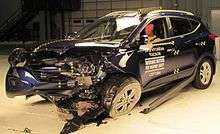
The second-generation Hyundai Tucson earned 'Top Safety Pick' award from Insurance Institute for Highway Safety (IIHS) in the U.S.[26]
| Moderate overlap frontal offset | Good |
| Small overlap frontal offset | Poor |
| Side impact | Good |
| Roof strength | Good |
Third generation (TL; 2015)
| Third generation (TL) | |
|---|---|
_Active_X_wagon_(2018-08-27)_01.jpg) | |
| Overview | |
| Production | 2015–present |
| Assembly |
|
| Designer | Peter Schreyer |
| Body and chassis | |
| Related | |
| Powertrain | |
| Engine |
|
| Transmission | |
| Dimensions | |
| Wheelbase | 2,670 mm (105.1 in) |
| Length | 4,475 mm (176.2 in) 4,545 mm (178.9 in) (China) |
| Width | 1,850 mm (72.8 in) |
| Height | 1,645 mm (64.8 in) 1,670 mm (65.7 in) (China) |
| Curb weight | 1,488–1,702 kg (3,280–3,752 lb) |
On February 17, 2015, Hyundai released the first details about its next-generation Tucson ahead of the crossover's official debut at the Geneva Motor Show on March 3, 2015. This model arrived in showrooms in the second half of 2015, as a 2016 model year, and for the first time will use the Tucson name in all markets where it is sold.[33]
During the Geneva show Hyundai also unveiled two concept variants, a Tucson hybrid electric and a diesel-powered plug-in hybrid. The 48V Hybrid combines a 2.0-liter diesel model with 134 hp (100 kW) and a six-speed manual transmission along with a 14 hp (10 kW) electric motor; combined system performance is 148 hp (110 kW) and 413 N·m (305 lb-ft) of torque. This boosts system power by 10% while emitting only 109 g/km CO
2. The concept plug-in-hybrid is also based on the all-new Tucson platform, is equipped with a 1.7-liter diesel engine and a seven-speed dual-clutch transmission. The engine generates 113 hp (85 kW) and is accompanied by a 67 hp (50 kW) electric motor and a 10.7 kWh lithium-ion polymer battery, which delivers an all-electric range of more than 50 km (31 mi). Combined system output is a maximum of 180 hp (135 kW) with 474 N·m (350 lb-ft) of torque, with estimated CO
2 emissions of less than 48 g/km.[34]
Powertrain
| Model | Years | Transmission | Power | Torque | 0-100 km/h (0-62 mph) (Official) |
Top speed |
|---|---|---|---|---|---|---|
| Petrol | ||||||
| Gamma II 1.6 GDi | 2015–present | 6-speed manual 6-speed automatic |
132 PS (97 kW; 130 hp) @ 6300 rpm | 16.4 kg⋅m (161 N⋅m; 119 lbf⋅ft) @ 4850 rpm |
|
|
| Gamma II 1.6 T-GDi | 6-speed manual 7-speed dual clutch automatic |
177 PS (130 kW; 175 hp) @ 5500 rpm | 27 kg⋅m (265 N⋅m; 195 lbf⋅ft) @ 1500-4500 rpm |
|
| |
| Nu 2.0 MPi | 6-speed manual 6-speed automatic |
155 PS (114 kW; 153 hp) @ 6200 rpm | 19.6 kg⋅m (192 N⋅m; 142 lbf⋅ft) @ 4000 rpm |
|
186 km/h (116 mph) (FWD Manual) 181 km/h (112 mph) (FWD Automatic) 184 km/h (114 mph) (AWD Manual) 180 km/h (112 mph) (AWD Automatic) | |
| Nu 2.0 GDi | 6-speed automatic | 163 PS (120 kW; 161 hp) @ 6200 rpm | 20.8 kg⋅m (204 N⋅m; 150 lbf⋅ft) @ 4500 rpm | |||
| Theta II 2.0 MPi | 165 PS (121 kW; 163 hp) @ 6000 rpm | 20.1 kg⋅m (197 N⋅m; 145 lbf⋅ft) @ 4000 rpm | ||||
| Theta II 2.4 MPi | 6-speed manual 6-speed automatic |
176 PS (129 kW; 174 hp) @ 6000 rpm | 23.2 kg⋅m (228 N⋅m; 168 lbf⋅ft) @ 4000 rpm | |||
| Theta II 2.4 GDi | 6-speed automatic | 184 PS (135 kW; 181 hp) @ 6000 rpm | 24.2 kg⋅m (237 N⋅m; 175 lbf⋅ft) @ 4000 rpm | 9.6s | 192 km/h (119 mph) | |
| Diesel | ||||||
| 1.6 U II CRDi | 2019–present | 6-speed manual 7-speed dual clutch automatic |
115 PS (85 kW; 113 hp) @ 4000 rpm 136 PS (100 kW; 134 hp) @ 4000 rpm |
28.6 kg⋅m (280 N⋅m; 207 lbf⋅ft) @ 1500-2750 rpm 32.6 kg⋅m (320 N⋅m; 236 lbf⋅ft) @ 2000-2250 rpm |
|
|
| 1.7 U II CRDi | 2015-2018 | 6-speed manual (116 PS) 7-speed dual clutch automatic (141 PS) |
116 PS (85 kW; 114 hp) @ 4000 rpm 141 PS (104 kW; 139 hp) @ 4000 rpm |
28.6 kg⋅m (280 N⋅m; 207 lbf⋅ft) @ 1250-2750 rpm 34.7 kg⋅m (340 N⋅m; 251 lbf⋅ft) @ 1750-2500 rpm |
13.7s (116 PS Manual) 10.6s (141 PS DCT) |
176 km/h (109 mph) (116 PS Manual) 186 km/h (116 mph) (141 PS DCT) |
| 2.0 R II CRDi | 2015-2018 | 6-speed manual | 136 PS (100 kW; 134 hp) @ 2750-4000 rpm | 38 kg⋅m (373 N⋅m; 275 lbf⋅ft) @ 1500-2500 rpm | 10.6s | 187 km/h (116 mph) |
| 2019–present | 6-speed manual 8-speed automatic |
185 PS (136 kW; 182 hp) @ 4000 rpm | 40.8 kg⋅m (400 N⋅m; 295 lbf⋅ft) @ 1750-2750 rpm | 9.9s (Manual) 9.5s (Automatic) |
201 km/h (125 mph) | |
2019 refresh
First shown at the 2018 New York Auto show, the Hyundai Tucson for the 2019 model year received a facelift and significant changes to the powertrain options. Exterior updates included a new cascade grille, reshaped hood and tailgate design, rectangular fuel door, new rim designs, and an updated LED headlight design for higher trim levels. The interior received a major update to include a newly designed dash with lower centrally-placed air vents and a high-mounted head unit display. A new safety feature named Driver Attention Warning (DAW) system is standard across all trim levels, and both the Lane Keeping Assist (LKA) departure/correction system and Front Collision Avoidance Assist (FCA) system are now also standard across all trim levels. The manual and dual clutch transmission options were dropped in favor of the 6-speed Shiftronic automatic used in previous model years and is available with Front-Wheel-Drive (FWD) or All-Wheel-Drive (AWD). The 2.0L Nu GDI engine continues in the SE and Value trim levels but for other trims the 1.6L I-4 turbocharged engine was dropped and replaced by a 2.4 Liter I-4 GDI naturally aspirated engine which produces 181 hp at 6000 rpm and 175 lb-ft (237 N.M) with a slight loss in fuel economy.[36] For the Chinese market, the Tucson was given an alternate facelift for the 2019 model year with the single model name known as 280TGDi and 6 separate trim levels. The 1.6 litre G4FJ engine is available paired to a 7 speed dual clutch gearbox. Pricing ranges between 155,900 and 239,900 yuan (23,260 to 35,800 USD).[37]
In spring 2019 Hyundai started selling the sportier variant N-Line.[38]
Pre-facelift styling
_Active_X_2WD_wagon_(2018-09-17)_01.jpg) Front
Front_Active_X_2WD_wagon_(2018-09-17)_02.jpg) Rear
Rear
Post-facelift styling
 Front
Front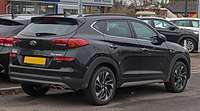 Rear
Rear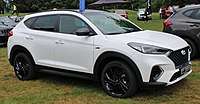 N Line
N Line
Chinese market post-facelift styling
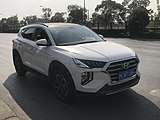 Front
Front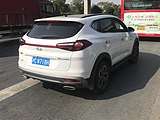 Rear
Rear
Sales
| Calendar year | United States[39] |
|---|---|
| 2004 | 7,074 |
| 2005 | 61,048 |
| 2006 | 52,067 |
| 2007 | 41,476 |
| 2008 | 19,027 |
| 2009 | 15,411 |
| 2010 | 39,594 |
| 2011 | 47,232 |
| 2012 | 48,878 |
| 2013 | 41,906 |
| 2014 | 47,306 |
| 2015 | 63,591 |
| 2016 | 89,713 |
| 2017 | 114,735 |
| 2018 | 142,263 |
| 2019 | 137,381 |
References
- "2017 Hyundai Tucson – Features and Specs - Hyundai".
- "Hyundai Build and Price a Tucson".
- "2016 Hyundai Tucson Limited 4dr Front-wheel Drive Pricing and Options".
- "2007 Hyundai Tucson - Specifications - Car Specs - Auto123". auto123.com. Retrieved 29 October 2018.
- "2005 Hyundai Tucson - Specifications - Car Specs - Auto123". auto123.com. Retrieved 29 October 2018.
- "2006 Hyundai Tucson - Specifications - Car Specs - Auto123". auto123.com. Retrieved 29 October 2018.
- Carfind.ca. "2007 Hyundai Tucson FWD Specifications - Winnipeg Used Cars, Winnipeg Used Trucks, Manitoba Used Cars, Manitoba Used Trucks, Used Vehicle Reviews, Safety Recalls, Used Cars for Sale in Manitoba". www.carfind.ca. Retrieved 29 October 2018.
- https://wwwb.autotrader.ca/cars/hyundai/tucson/2004/
- 2009 Hyundai Tucson NHTSA Star Rating CarsDirect.com
- "Hyundai Tucson Hybrid FCEV". Hydrogen-motors.com. 2008-10-21. Archived from the original on 2015-09-24. Retrieved 2010-09-26.
- Keegan, Walter J (2005-12-18). "L.A. Auto Show: Hyundai Tucson FCEV". Autoblog.com. Retrieved 2010-09-26.
- Abuelsamid, Sam (2008-11-19). "LA 2008: Hyundai announces Blue Drive efficiency strategy, 2010 Sonata hybrid". Green.autoblog.com. Retrieved 2010-09-26.
- Nunez, Alex (2007-03-27). "In UK, Hyundai Tucson reaches its Xenith". Autoblog.com. Retrieved 2010-09-26.
- "Hyundai Tucson 25th Anniversary Edition". Hyundaicanada.com. Archived from the original on 2011-07-12. Retrieved 2010-09-26.
- "2009 Hyundai Tucson 25th Anniversary Edition Road Test Review". Carpages.ca. 2008-11-15. Archived from the original on 2009-08-01. Retrieved 2010-09-26.
- Consumer Reports' 2009 Annual Car Reliability Survey Archived 2009-10-31 at the Wayback Machine October 27, 2009. Reuters
- "EUIPO - eSearch". Archived from the original on 2015-01-11.
- "Thomas Bürkle". Hyundai Motor UK Ltd. Archived from the original on 2013-10-02. Retrieved 2013-08-12.
- Edmunds Used Car Guide, (retrieved 28 July 2015).
- Abuelsamid, Sam (2009-08-18). "Frankfurt Preview: Hyundai officially teases the new Tucson *UPDATED". Autoblog.com. Retrieved 2010-09-26.
- "Hyundai Launches The ix35 Compact SUV On The Shanghai Auto Show".
- Ramsey, Jonathon (2009-08-09). "Hyundai ix35 (i.e. the new Tucson) spotted in Sydney". Autoblog.com. Retrieved 2010-09-26.
- New Hyundai ix35 Car Archived 2011-07-08 at the Wayback Machine September 08, 2009. CarTradeIndia.com
- Made in Germany | Hyundai`s success - Designed in Germany 2009, DW-TV (Deutsche Welle)
- "Hyundai Unveils Redesigned 2010 Tucson". Automoblog.net.
- https://www.iihs.org/iihs/ratings/vehicle/v/hyundai/tucson-4-door-suv/2013
- "Archived copy". Archived from the original on May 3, 2013. Retrieved May 19, 2013.CS1 maint: archived copy as title (link)
- AE, Rédaction (29 October 2016). "Le premier véhicule Hyundai " made in Algéria " est sorti ce samedi - Algerie Eco". Retrieved 29 October 2018.
- "Com motor 1.6 turbo, New Tucson terá preço inicial de R$ 138.900". Retrieved 29 October 2018.
- https://www.thecarconnection.com/overview/hyundai_tucson_2015
- https://wwwb.autotrader.ca/research/hyundai/tucson/2015/
- "Hyundai Tucson models specifications - Auto Types". www.auto-types.com. Retrieved 29 October 2018.
- 2016 Hyundai Tucson Press Release 02/17/2016. AutoBlog
- Mike Millikin (2015-03-08). "Hyundai showcasing new Tucson 48V Hybrid Concept and diesel Plug-in-Hybrid Concept at Geneva". Green Car Congress. Retrieved 2015-03-29.
- https://www.hyundai.com/worldwide/en/suv/tucson/highlights
- Stefan Ogbac. "2019 HYUNDAI TUCSON FIRST LOOK: GOODBYE TURBOCHARGER". Motortrend.
- "Hyundai Tucson facelift for the Chinese market".
- "Hyundai Tucson 1.6 CRDi N-Line 2019 review".
- "Official Media Site - Hyundai Newsroom". www.hyundainews.com. Retrieved 29 October 2018.
External links
| Wikimedia Commons has media related to Hyundai Tucson. |
- Official website
- Hyundai Tucson at the Internet Movie Cars Database
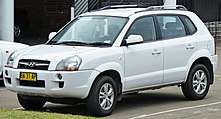
_02.jpg)